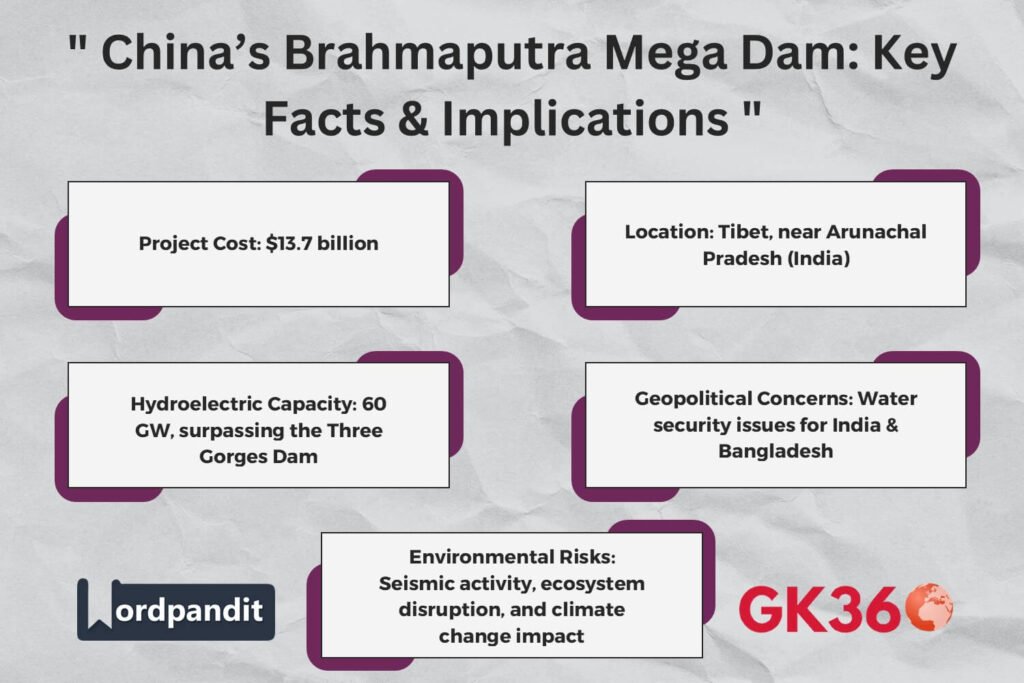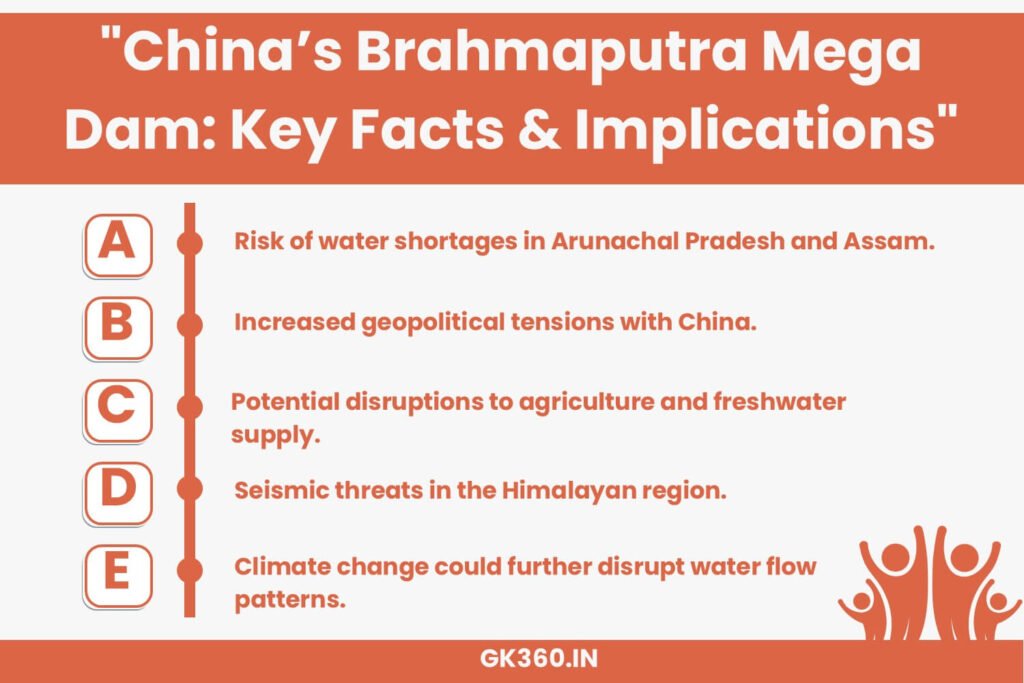China’s Brahmaputra Mega Dam: Geopolitical, Environmental, and Economic Fallout
Introduction
China’s recent approval of a $13.7 billion mega dam project on the Brahmaputra River, near the Indian border, has sparked widespread discussions about its geopolitical, environmental, and economic impacts. Officially known as the Yarlung Tsangpo in Tibet, the Brahmaputra River is crucial for millions in both China and downstream nations, including India and Bangladesh. This development raises significant concerns about regional water security and ecological stability, especially given the already strained India-China relations.

Table of Contents
- Key Highlights of the Project
- Geopolitical Implications
- Environmental Concerns
- India’s Response & Preparations
- Global Reactions
- FAQs on China’s Brahmaputra Mega Dam
- Conclusion & Call to Action
Key Highlights of the Project
1. Project Scale and Investment
The mega-dam is part of China’s ambitious 14th Five-Year Plan and is expected to be the largest hydroelectric project in the world, surpassing even the Three Gorges Dam. The dam, estimated at $13.7 billion, will be constructed in the Tibetan Autonomous Region, near Medog County, close to the Indian state of Arunachal Pradesh.
2. Strategic Importance
Located near the Indian border, this project is not just an engineering marvel but also a strategic move. By controlling water flow, China could potentially influence water availability in downstream regions, raising concerns about water as a geopolitical tool.
3. Hydroelectric Capacity
Once completed, the dam is expected to generate 60 gigawatts of power annually, significantly boosting China’s renewable energy capacity and meeting the demands of its rapidly growing population and industries.
Geopolitical Implications
1. India-China Relations
The dam’s proximity to Arunachal Pradesh, a region contested by China, complicates an already tense geopolitical relationship. India views the project with suspicion, fearing its potential to control or divert water resources critical for Indian agriculture and livelihoods.
2. Water Diplomacy Challenges
While China has assured that the dam will focus solely on hydroelectric power generation and will not affect downstream water flow, there is no formal water-sharing agreement between China and India. This lack of transparency exacerbates mistrust between the two nations.
3. Impact on Bangladesh
As a downstream nation, Bangladesh also relies on the Brahmaputra River for its agricultural and freshwater needs. Any alteration in the river’s flow could have cascading effects on its economy and ecology.
Environmental Concerns
1. Ecological Impact
The construction of such a massive dam poses significant risks to the fragile Himalayan ecosystem. Altered water flow, sediment retention, and habitat disruption could severely affect biodiversity and local communities.
2. Seismic Risks
The Himalayan region is highly prone to earthquakes. Building a massive dam in this seismically active zone could increase the risk of structural damage and catastrophic flooding in the event of a disaster.
3. Climate Change Considerations
Changing precipitation patterns and glacial melting due to climate change further complicate the project’s feasibility and long-term impacts.
India’s Response & Preparations
India has expressed strong concerns over China’s unilateral actions on shared water resources. The Indian government is reportedly considering its own dam project on the Brahmaputra to counter China’s influence. Additionally, experts have called for diplomatic engagement with Beijing to ensure water security for all downstream nations.
Global Reactions
The international community has taken note of the project’s implications for regional stability and environmental sustainability. Environmental organizations have urged China to conduct comprehensive environmental impact assessments and engage in multilateral discussions on shared water concerns.

FAQs on China’s Brahmaputra Mega Dam
Why is China building a mega dam on the Brahmaputra?
China aims to increase its hydroelectric power capacity and enhance control over strategic water resources.
How does the dam affect India and Bangladesh?
It raises concerns over water security, ecosystem stability, and geopolitical tensions.
What are the environmental risks of this dam?
Seismic risks, ecological disruptions, and climate change vulnerabilities pose major threats.
Can India counter China’s dam strategy?
India is considering its own dam projects and diplomatic efforts to mitigate risks.
Is there an international treaty governing Brahmaputra water sharing?
No. China and India do not have a formal water-sharing agreement, leading to disputes over river management.
Conclusion & Call to Action
China’s approval of the $13.7 billion mega dam on the Brahmaputra River is a landmark development with far-reaching implications. While it promises significant advancements in renewable energy, it also raises serious concerns about water security, environmental degradation, and geopolitical tensions.
For India and other downstream nations, this is a call to prioritize water diplomacy, enhance regional cooperation, and push for sustainable solutions to shared water challenges.
Key Takeaways Table
| Aspect | Details |
|---|---|
| Project Cost | $13.7 billion |
| Location | Tibet, near Medog County, close to Arunachal Pradesh (India) |
| Hydroelectric Output | 60 GW (World’s largest hydroelectric project) |
| Strategic Concerns | Potential control over water flow into India & Bangladesh |
| Environmental Impact | Seismic risks, biodiversity loss, sediment flow disruption |
| India’s Response | Considering counter-dams and diplomatic engagement |
| Global Reaction | Calls for transparency and multilateral water-sharing agreements |
Related terms
- China Brahmaputra Dam Project
- Brahmaputra River Water Dispute
- India-China Water Tensions
- Tibet Hydroelectric Mega Project
- Geopolitical Impact of China’s Dams
- Brahmaputra Water Security India
- China’s Hydro Diplomacy in South Asia
- Environmental Risks of Mega Dams
- Brahmaputra River Climate Change Impact
- India’s Response to China’s Dam Projects





